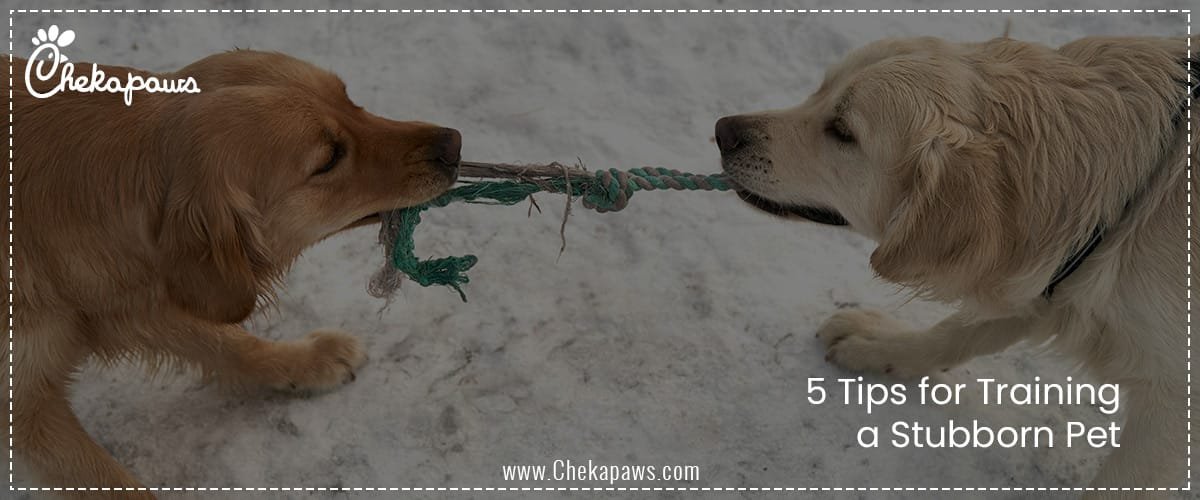As a pet parent, I am aware that some pet can be stubborn. One of the most satisfying parts of pet ownership is training your pet, but it can also be one of the most annoying if your pet is uncooperative. A parrot who repeats everything but your commands, a dog that won’t come when called, or a cat that will not stop scratching the furniture are just a few examples of how stubbornness can manifest itself.
Often, what we call “stubborn” behavior is simply a misalignment between our expectations and what the creature knows or is driven to perform. Pets have unique personalities, temperaments, and learning methods just like people do. A pet that is deemed stubborn may simply be disinterested in what you’re doing, confused, afraid, or distracted.
This guide is meant to assist you in filling that gap. You will discover how to approach training with understanding, patience, and efficient methods that suit the way animals learn best, rather than getting upset over your pet’s behavior.
Table of Contents

Understand Your Pet’s Motivation
The Value of Motivation
No action, whether human or animal, is in vain. Effective training begins with knowing what motivates your pet’s behavior. Food, play, attention, independence, comfort, or even avoiding an uncomfortable situation might serve as motivation.
For instance, the “Stubborn” dog that refuses to come when called
Is your dog ignoring you if they refuse to come when you call for them to? Or because they are aware that seeing you signifies the end of the enjoyment (like when they go to the park to play)? Your pet’s actions are frequently perfectly reasonable given what they are craving at the time.
How to Identify Your Pet’s Motivators
Examine your pet in different environments: Pay attention to what they are drawn to. Are they treats? Playthings? Cuddles? Some individuals?
Try out various rewards: Give your pet a variety of treats to see which ones they enjoy the most. Some pets are food-driven, while others may prefer a game of fetch or verbal praise.
Think about the situation: A motivation that works in one setting might not in another. For instance, if your dog is obsessed with a squirrel, a treat might not be as useful.
Adapting Instruction to Encouragement
- Once you know what really drives your pet, make good use of it:
- high-value incentives for challenging conduct or in situations with significant distractions.
- lower-value incentives for simpler upkeep or chores.
- To keep things fresh and interesting, save special rewards for training exclusively.
- Learning is fueled by motivation. It’s not that your pet is being uncooperative; rather, it’s because you haven’t yet provided them with anything they genuinely value.
Use Positive Reinforcement Strategically
The Science behind It
Giving your pet what they want when they do something you appreciate is known as positive reinforcement. All animals, from rodents to dolphins—yes, even your obstinate dog or cat—can benefit from its foundation in behavioral research.
Positive Reinforcement: What Is It?
- Treats: The best are little, delicate, and delicious.
- Praise: Expressions such as “Well done!” in a positive manner.
- Toys: A favourite tug rope or noisy toy.
- Freedom: Allowing them to go free from a crate or off a leash.
The timing is important
- The desired behaviour must be followed right away by reinforcement:
- Even a 2- to 3-second delay can cause your pet to become confused.
- To help close the gap between behaviour and reward, use a marker (such as a clicker or the word “Yes!”).
Avoid These Common Mistakes
- Bribery rather than reward: Don’t reward good behavior before bad behavior.
- Inconsistent rewards: They may become confused or lose interest if they receive a treat occasionally and none at other times.
- Reinforcing undesirable behavior: You might be encouraging your dog to jump if you give them attention—even a reprimand.
Using Strategic Reinforcement to Develop Positive Habits
- Make use of reinforcement to:
- Develop intricate behaviours gradually.
- Make training enjoyable and stress-free.
- Create a close relationship with your pet.
Be Consistent and Predictable
Pets Benefit from Routine
Your pet will better understand expectations if you are consistent with them. Your pet will become confused and training will be delayed if you use inconsistent cues, rewards, or rules.
Make Use of Consistent Orders
- For every command, choose one word and use it consistently. Avoid switching between “Down” and “Lay.”
- Make sure everyone in the family follows the same routines and cues.
Establish a Training Schedule
- Daily sessions of five to ten minutes are preferable to sporadic marathons.
- To cut down on confusion, use the same setting, voice, and resources.
- Finish on a positive note with a victory and a reward.
Predictable Outcomes
- Desired behavior should be consistently followed by rewards.
- Rewarding or attracting attention should never result from undesirable behavior.
- For instance, you’re reinforcing the very behavior you’re trying to prevent if jumping results in you pushing the dog away, which they enjoy.
Things to Support Consistency
- Training logs to monitor routines and progress.
- For clarity, use clickers or marker words.
- Visual schedules are particularly helpful when children are assisting with training.
- Clarity and trust are increased by consistency. When your cues are unclear or unpredictable, your pet becomes confused, not stubborn.
Break Training into Small, Achievable Steps
The Power of Small Wins
Asking too much too quickly frequently results in stubborn behaviour. Divide complicated behaviours into manageable chunks; this is known as shaping.
- Teaching “Go to Bed” is one example. Bring your pet onto the mat.
- Give credit for any strategy.
- Increase their stay time gradually.
- Once the behavior is dependable, add the verbal cue.
Use a Step-by-Step Approach
- Lure → Capture → Name → Generalize.
- Wait until the behaviour occurs consistently before adding the command word.
- Before proceeding, don’t wait for perfection, but also don’t hurry.
When Your Pet “Refuses” a Command
It could be
- Too challenging
- Too recent for that situation
- connected to a bad thing
- Not adequately reinforced in the past
- Take a step back. Appreciate minor advancements. Boost your efforts.
Award progress rather than perfection
Reward your cat if they touch the scratching post once rather than the couch.
Reward your dog if they don’t bark for ten seconds as opposed to just one!
This prevents frustration and maintains a positive training environment for both of you.
Stay Calm, Patient, and Persistent
Failure Is Caused by Frustration
Emotional control on the part of the human is as important to training as behavior modification for the pet. Your energy, tone, and stress are all sensed by pets.
Why Punishment Doesn’t Work
- Exacerbates confusion and fear
- Ruins your relationship
- Able to intensify problematic behaviors
Pause the session if you’re feeling irritated. Never work out when you’re upset or impatient.
The Power of Persistence
- Pets that are stubborn frequently require:
- Additional repetition
- More endurance
- More originality in environments and rewards
- Even though progress may seem slow, little, consistent gains add up.
- Continue to Have a Growth Mentality
- All pets are capable of learning.
- Failures are common.
- Speed is not as important as your bond.
- Keep track of milestones. Record videos. Celebrate each victory.
Support for Your Emotions
Training a pet can be isolating and draining. Participate in online forums. If necessary, collaborate with a certified trainer. There is no shame in asking for assistance.
Conclusion
You may have realised by now that your pet is simply misunderstood and not stubborn at all. Often, what appears to be disobedience is actually misunderstanding, a lack of drive, or inconsistent instruction.
Let’s redefine the term “obstinate”:
Perhaps a “stubborn” dog simply needs more encouragement.
More tolerance and inventive reinforcement might be needed for a “stubborn” cat.
A parrot that is “stubborn” may be responding to erratic cues or traumatic experiences.
Dominance and control are not the goals of training. It all comes down to mutual respect, trust, and communication. The five strategies discussed in this guide are philosophies that promote patience, compassion, and clarity rather than merely methods.







